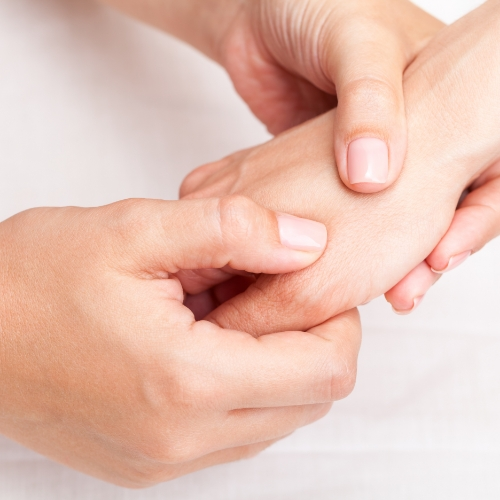Why Physical Therapy is the Proven Choice For Addressing Hand Pain
Is persistent hand pain holding you back? Whether it’s caused by an injury, overuse, or arthritis, hand pain can keep you from your favorite activities. Fortunately, at Full Potential Physical Therapy, we offer effective, research-based approaches that address your pain at its source.

When your hands are in pain, simple tasks start to feel insurmountable. You might struggle to type on your computer, pick up utensils, use your phone, and more–all of which can significantly affect your work and personal life.
Other symptoms that can make day-to-day living a challenge often accompany hand pain, too, including the following:
- Stiffness
- Swelling
- Reduced range of motion
The good news is that a customized physical therapy program can help you overcome these limitations and regain everyday functionality. By incorporating a blend of evidence-based techniques such as manual therapy or therapeutic exercise, our tailored treatment plans will help to alleviate your pain.
Because we want you to see results, we’ll work with you to identify the most effective methods to treat your specific symptoms. In addition to helping you reduce pain in the present, we’ll address any underlying ergonomic issues contributing to your discomfort–which can also help prevent future injuries.
Don’t let hand pain keep you from work or your favorite leisure activities. Schedule your personalized consultation with our expert physical therapists today and discover the difference a comprehensive, evidence-based treatment approach can make.
You deserve lasting relief from hand pain! Request your appointment at Full Potential Physical Therapy today.
Tracking Down the Roots of Hand Pain
Several conditions and injuries can cause hand pain. To develop the best treatment for you, our experts will identify what’s causing your pain before applying the latest research and treatment techniques to resolve the issue. That way, we’re treating the source of your pain, not just the symptoms.
Here are some of the most common causes of hand pain:
Carpal Tunnel Syndrome
This condition occurs when the median nerve, which runs from the forearm to the hand, becomes compressed in the carpal tunnel, a narrow passageway between the wrist bones. It can cause pain, numbness, and tingling in the hand and fingers. Typing or repetitive hand movements can worsen the condition.
Arthritis
Arthritis is a general term used to describe inflammation of the joints and can occur in any joint in the body, including the hands. Osteoarthritis and rheumatoid arthritis are the most common types of arthritis that affect the hands and can cause pain, swelling, and stiffness in the fingers and wrists.
De Quervain’s Tenosynovitis
This condition occurs when the tendons that control the movement of the thumb become inflamed and irritated, leading to pain and tenderness on the thumb side of the wrist. Activities that involve gripping or twisting may worsen your symptoms.
Trigger Finger
This condition occurs when a tendon in the finger becomes inflamed and swollen, causing the finger to become stuck in a bent position and leading to pain and stiffness in the affected finger.
No matter what condition is causing pain and limited mobility in your hands, we’ll help you identify and treat it. Our evidence-based treatment approaches can reduce pain, decrease inflammation, and restore functionality.
Contact us today to schedule an evaluation and start your journey to hand pain relief!
Physical Therapy Treatments for Addressing Hand Pain
When you come in for your initial appointment at Full Potential Physical Therapy, our physical therapists will begin with a comprehensive assessment process, including a thorough review of your medical history and several physical tests and evaluations. We’ll examine the range of motion in your wrist and fingers, your grip strength, and more.
Once we have a complete picture of your symptoms and condition, we’ll develop your customized treatment plan. Every technique in your plan will be backed by peer-reviewed research and designed to reduce pain and improve tissue and joint mobility, strength, and overall function. Some of the most common treatments include:
- Manual Therapy: These hands-on techniques mobilize and manipulate the joints, soft tissues, and nerves in your hands and wrists. They can alleviate pain, improve mobility, facilitate tissue healing, and promote a faster recovery.
- Therapeutic Exercises: These customized exercises will target your specific areas of concern. You can optimize your physical therapy results by developing strength, flexibility, and coordination in your hands.
- Splinting and orthotics: Our therapists may recommend custom splints or orthotics to support and protect the hand during healing. These devices can facilitate proper joint alignment and prevent further injury–and each one is designed to fit you.
- Modalities: Modalities such as ultrasound, electrical stimulation, and hot or cold therapy help reduce inflammation, improve blood flow, and relieve pain. When combined with manual therapy and exercise, you’ll get the results you’re looking for.
- Patient education: Often, simple lifestyle changes can help you manage hand pain. Our experts can provide information about at-home exercises, ergonomic adjustments, and other tips to prevent future issues.
When you visit Full Potential Physical Therapy for physical therapy, you know you’re receiving a top-notch, evidence-based treatment plan designed around your needs, goals, and ability levels. We’ll help you manage your symptoms and work toward lasting relief.
Call us at (616) 392-2172 today to schedule your initial consultation in Holland, MI!
A Better Life is Only Four Steps Away
Physical therapy can be an unfamiliar experience for many. To orient new patients to the process, we have divided their rehab journey into four segments called “The Four Phases of Getting Better.” It is important to note that while there are four phases utilized over the course of your care, they are not totally separate. They move gradually toward greater strengthening and function, which is the end goal to return confidently to the life you desire to live.1
Pain Relief
The first focus in getting better is pain relief. After your evaluation, your physical therapist will use hands-on techniques or manual therapy, light therapeutic exercise, and education on how to modify your activity and posture in order to give you more control over your pain. In this stage, modalities like ice, heat, myofascial release, electric stimulation and kinesiotape may be used.
2
Improve Mobility/Flexibility
The second step in this method is to improve mobility and flexibility. Your therapist will design a progressive program of range of motion and light stretching to restore mobility and reduce pain.
3
Improve Strength/Control
In the third step of this method, muscle weakness will be addressed to help you maintain the gains and momentum you achieve through phases one and two. A thorough strengthening process is the step that gives results that last, and this will prepare you for more functional training – the final step.
4
Functional Training
Now that your pain is resolved and you have the necessary mobility and strength, your program can be advanced into functional training. Whether you are returning to work, returning to life after post-op rehabilitation, getting back into recreation or sports, or simply returning to the activities of daily life, this step helps ensure your success after graduation and empowers you to be confident in your abilities again.

Reach Your Full Potential & Live Pain-Free!
Book A Free Consultation
Book a Free Consultation Today to Find Out How Physical Therapy Can Help You Find Relief!
request an appointment
Reach Your Full Potential and Live Life Pain-Free! Request an Appointment to Get Started Today!





